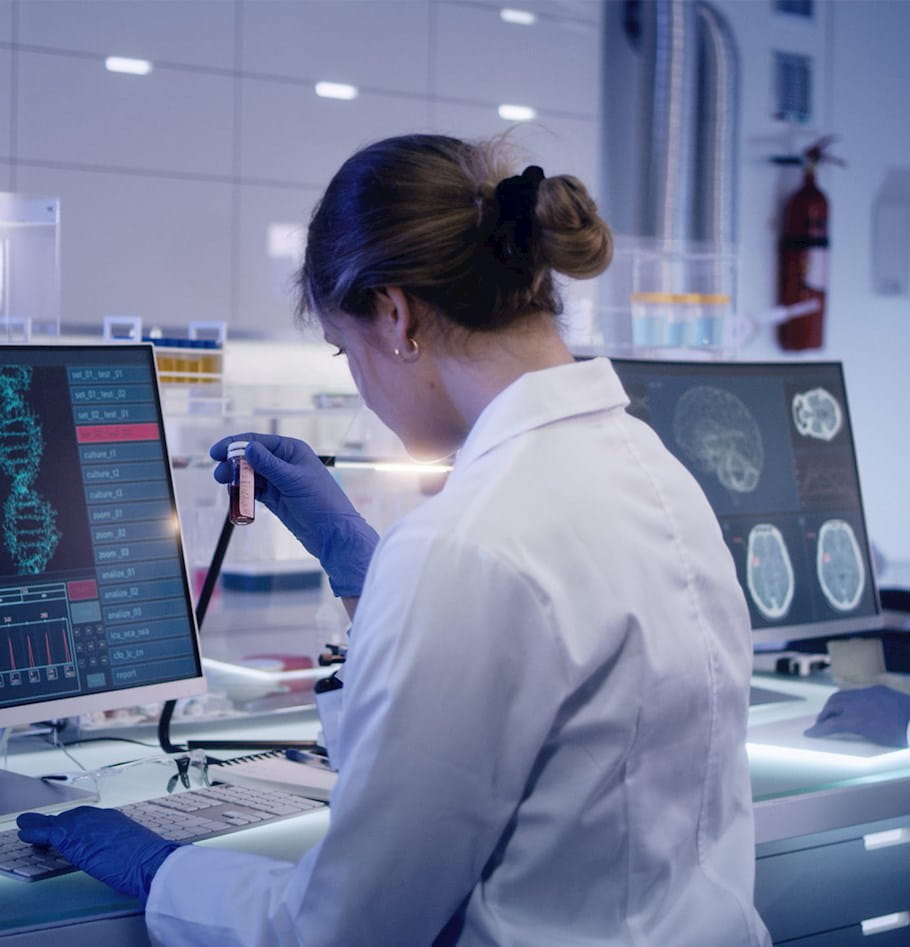Diagnostic industry dynamics in life sciences: Growth, challenges, and key trends
The global diagnostic market is exploding—and data-led innovation will drive success
The global diagnostic market size is projected to double in the next decade, increasing from the current $165.6 billion to nearly $350 billion. It's expected to grow 4.6% in the United State to $40.1 billion by 2026, fueled by the convergence of advancing diagnostic technologies and a rising demand for clinical diagnostics.
This favorable landscape has attracted new entrants and investors eager to capitalize on the opportunities. But those opportunities won’t come without their own challenges in an evolving industry. Organizations that can overcome these hurdles through cost efficiency, data-driven strategies, and innovative approaches will find success in shaping its trajectory.
High costs and slow turnaround times for precision medicine delivery
To understand why precision medicine is costly and often time-consuming, it is essential first to understand the field of genomic medicine and its role in driving advancements in precision healthcare. The field is broadly divided into two distinct areas: the techniques and technologies for identifying or sequencing genomes and the methods for analyzing and interpreting the data generated from this sequencing. Innovation today converges in both areas, propelling the field into rapid growth.
There has been an extraordinary evolution in genome sequencing technologies in the past two decades. Innovations such as Next Generation DNA Sequencing (NGS) technologies by 454 Life Sciences (Roche Diagnostics), Solexa (Illumina), and Applied Biosystems (Life Technologies, Thermo Fisher Scientific) have enabled parallel sequencing, simultaneously processing billions of DNA fragments.
The impact of these technologies is best illustrated by the fact that the cost of sequencing a human genome decreased from $2.7 billion in 2003 to $10,000 in 2013. Today, the cost is approximately $600 and is projected to continue decreasing in the coming years.
However, the subsequent challenge lies in effectively processing the vast and intricate datasets generated from this massive parallel sequencing. This is the promise of precision medicine, and companies such as 10x Genomics, OnRamp Bioinformatics, and Genoox are empowering life science and diagnostics companies to transform genomic data into actionable insights. For example, Visium Spatial Gene Expression from 10X Genomics is a specialized tool for mapping and analyzing all the genes in a piece of tissue across different body regions. This, in turn, helps tailor treatments accordingly—offering a more personalized and effective approach to addressing health concerns.
It's crucial to acknowledge that, despite these remarkable strides in precision medicine, the costs associated with it are still notably high and turnaround times are relatively slow. But as the industry moves beyond its early stages of development and matures, the formation of strategic partnerships and the breakdown of information silos should lead to further cost reductions and faster turnaround times. The merging of innovation in genomic medicine and continuously advancing analytics capabilities holds potential for applications ranging from clinical diagnostics in genetics to optimized clinical trials and drug delivery.
Inability to pull clinical diagnostics insight from extensive patient data
The diagnostics industry is particularly interested in applying advancements in artificial intelligence (AI) and machine learning to improve accuracy, speed, and efficiency for understanding changes in patient’s measurable vitals. With the advent and adoption of wearable devices, mobile apps, and telehealth platforms, patients and their doctors can access remote monitoring and real-time, patient-generated health data collection.
A well-known example is the continuous glucose monitoring (CGM) systems from companies like Dexcom, Abbott, and Medtronic that are game changers for diabetes patients by allowing for real-time data monitoring and sharing, improved glucose control, and reduced need for fingerstick testing. Companies are amassing an abundance of patient-generated health data as the adoption of these devices grows.
Unfortunately, the ability to analyze and draw new findings from these datasets has remained limited due to regulatory and privacy challenges. From pre-market approval and clearance to post-market surveillance, regulatory agencies struggle to keep up with the pace of innovation or the extensive range of products. There are currently no good proxies for evaluating the relative risks of these new approaches, and some products fall in the companion diagnostics or general wellness realm—while others are seen more as digital therapeutic or software as a medical device (SaMD).
It's difficult for manufacturers to explain safety and efficacy to regulators and doctors as algorithms are often not translatable or are written to evolve continuously. One way to tackle this is by bringing expert practitioners into the regulatory space to help provide context and expertise to policy. By doing this, regulators can balance creating a policy that ensures patient safety and allows innovation.
In conjunction with regulatory challenges, patient data privacy and protection remain a top concern for many patients and continue to pose a struggle for health systems, their providers, and associated third-party vendors. Data protection solutions will be highly valuable as real-time monitored devices are further adopted. Techniques such as differential privacy, federated learning, and secure computation can enable data analysis and aggregation while preserving individual patient privacy and confidentiality.
While those are solutions at the patient level, the risk of ransomware and cybersecurity-related issues continues to instill fear and resistance. As AI evolves, it promises to help address these concerns and provide solutions. For example, two players, Tempus and Zebra Medical Vision, have found the power of anonymizing patient data securely to create large datasets that can help with more efficient diagnoses of cancer and chronic conditions.
Regulatory and privacy challenges remain prevalent, but companies and new entrants that can navigate the evolving landscape and leverage new AI and ML technologies will lead the way in the innovation of diagnostics by pulling insights from patient data.
Extended wait period for centralized clinical diagnostics
In a centralized clinical diagnostic model, collected patient samples are sent to a centralized laboratory for testing, which invariably results in patients potentially waiting days to receive their results and risks delaying treatment decisions. Additionally, logistical challenges during the transportation of these samples from collection facilities to centralized labs may lead to sample mishandling, contamination, or further delays in transit. Centralized clinical diagnostics are unsuitable for making rapid decisions in emergencies or medical situations requiring immediate intervention.
To mitigate these challenges, healthcare systems often integrate point of care diagnostics with centralized diagnostics to improve the efficiency and speed of results. Over the years, these diagnostic tools have evolved from single-marker tests to multiplexed platforms capable of detecting various diseases and biomarkers. The point of care diagnostics industry has several companies already developing and manufacturing a wide range of point of care testing devices, from rapid diagnostic tests to portable analyzers providing diagnosis of diseases such as COVID-19, SARS, STIs, and colon cancer.
Recent progress in point of care diagnostics has made them more accessible to users, enhanced their portability, and lowered costs by leveraging engineering enhancements. Advancements in automation for point of care testing equipment reduce manual intervention, streamline workflows, and minimize the requirement for extensive laboratory infrastructure, enabling non-specialized personnel to operate these devices effectively.
There have also been a range of new entrants in the industry that are at the forefront of developing and advancing point of care diagnostics technologies:
- Mammoth Biosciences: Pioneering CRISPR-based diagnostics for highly specific and rapid disease testing
- Talis Biomedical: Focused on developing diagnostic panels for infectious diseases and women's health
- Clip Health: Developing smartphone-based diagnostic technology
Persistent pricing and reimbursement challenges
According to payers, one of the top factors preventing comprehensive reimbursement for genome sequencing tests is the tests’ clinical utility. In recent years, however, there have been advancements in illustrating that these tests are effective. Evidence for clinical utility comes from robust clinical studies completed by diagnostic companies that generate supporting data and outcomes demonstrating the clinical effectiveness of these tests.
For example, Exact Sciences conducted extensive clinical studies involving thousands of patients to demonstrate the efficacy of Cologuard in diagnosing colon cancer. This disease impacts tens of thousands each year. GRAIL, a newer entrant, conducted large-scale clinical studies, specifically the circulating cell-free genome atlas (CCGA) studies, which involved tens of thousands of participants to generate robust evidence for their liquid biopsy technology. By demonstrating clinical utility at scale, companies can convey their value to payers and argue for further reimbursement and coverage.
In addition to more robust clinical studies, innovators in the space can conduct health economic evaluations, such as cost-effectiveness or cost-utility analyses, to quantify the economic impact of their diagnostic tests. By using these arguments to demonstrate business value, significant players and new entrants are progressing toward getting payers to reimburse testing. One example is the series of large-scale clinical studies and health economic evaluations conducted by Myriad Genetics to convey clinical utility and provide the business case for how their test could reduce cancer-related morbidity and mortality costs. For companies to succeed in clinical diagnostics, they must seek lower prices and reimbursement for patients, ultimately enhancing the adoption of their product and market share.
Conclusion
When analyzing advancements in diagnostics merely as isolated progress, a discernible blind spot emerges: an elusive grasp of the core growth catalysts propelling this industry. Leading companies are adopting innovative approaches that strike a balance between cost efficiency, optimal data utilization, accessibility, and financial sustainability.
The companies highlighted above play a pivotal role in propelling the industry's lofty growth ambitions, and the confluence of their innovations illuminates a path for a more efficient, accessible, and impactful diagnostic landscape.

